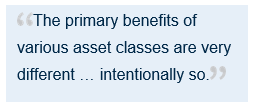Doug Drabik discusses fixed income market conditions and offers insight for bond investors.
If I were to ask you to match the following people (soccer parent, house contractor, doctor) with their corresponding vehicles (Ford F150, BMW 540i, Chrysler Town & Country minivan) I’m guessing I would get near 100% consensus (the house contractor drives the Ford F150, the doctor drives the BMW 540i and the soccer parent drives the minivan). Aside from obvious stereotypes, your analysis probably consciously and/or unconsciously assessed practical use, affordability, need and maybe in one case, luxury. The point is that each of these vehicles serves a real purpose functioning as a tailor-made fit for each individual. I’m sure the contractor wouldn’t mind driving the BMW… until he had to haul a couple of ladders and bags of concrete to a job site. You get the point.
The primary benefits of various asset classes are also very different… intentionally so. The greater the risk, typically the greater the reward. Conversely, a lower degree of risk generally means less reward. A billionaire can simply afford to take on more risk than a retired elderly person living off a fixed income stream. This constraint may dictate the retired person’s course of action, however, it does not necessarily indicate the billionaire’s choice of risk. Being able to absorb an equity market 50% pullback should not be confused with the desire to risk such an event. Every investor loves the upside triumph of an appreciating stock until they experience a downside capital plunge when that same stock loses 30% of its value. Again, you get the point.
Suppose you buy 1000 shares of XYZ stock at $100/share ($100,000). A 50% market pullback occurs, knocking the price of XYZ to $50. You now have a $50,000 value. If XYZ experiences a 50% surge, you only recover ½ of your previous loss [$50 + (50% x $50)] = $75. You actually need 100% price appreciation to just break even on your initial investment and to fully recover from the 50% pullback.
Now suppose you bought $100,000 ABC bond at par at a 3.10% yield, producing $3,100 of annual income. An interest rate surge pushes yields up 50 basis points and drops the price of ABC from $100 to $94. The cash flow
and income on your holding… remains $3,100/annually. The price of ABC could drop, go up or stay the same and it would not affect your cash flow, income or the date when you receive your $100,000 face value back. A buy and hold investor satisfied with the benefits of fixed income can dismiss any price changes over that holding period.
The market can move either way. Of course in a bull market run, XYZ might double in value. Greater risk, greater reward. On the other hand, the bond will perform exactly the same for a buy and hold investor regardless of interest rate changes or market price changes. Income will not be disrupted, cash flow will continue and barring an outright default, face value will be returned at maturity.
There is no right or wrong investment. They each serve a different purpose: in our examples, one of growth and the other of principal protection and income. The benefit of appropriate asset allocation can and should combine the growth prospects with a balance of principal protection. Stay disciplined in utilizing the benefits of appropriate asset allocation.
To learn more about the risks and rewards of investing in fixed income, please access the Securities Industry and Financial Markets Association’s “Learn More” section of investinginbonds.com, FINRA’s “Smart Bond Investing” section of finra.org, and the Municipal Securities Rulemaking Board’s (MSRB) Electronic Municipal Market Access System (EMMA) “Education Center” section of emma.msrb.org.
The author of this material is a Trader in the Fixed Income Department of Raymond James & Associates (RJA), and is not an Analyst. Any opinions expressed may differ from opinions expressed by other departments of RJA, including our Equity Research Department, and are subject to change without notice. The data and information contained herein was obtained from sources considered to be reliable, but RJA does not guarantee its accuracy and/or completeness. Neither the information nor any opinions expressed constitute a solicitation for the purchase or sale of any security referred to herein. This material may include analysis of sectors, securities and/or derivatives that RJA may have positions, long or short, held proprietarily. RJA or its affiliates may execute transactions which may not be consistent with the report’s conclusions. RJA may also have performed investment banking services for the issuers of such securities. Investors should discuss the risks inherent in bonds with their Raymond James Financial Advisor. Risks include, but are not limited to, changes in interest rates, liquidity, credit quality, volatility, and duration. Past performance is no assurance of future results.
Stocks are appropriate for investors who have a more aggressive investment objective, since they fluctuate in value and involve risks including the possible loss of capital. Dividends will fluctuate and are not guaranteed. Prior to making an investment decision, please consult with your financial advisor about your individual situation.
Markets & Investing Members of the Raymond James Investment Strategy Committee share their views on...
Markets & Investing Review the latest Weekly Headings by CIO Larry Adam. Key Takeaways ...
Technology & Innovation Learn about a few simple things you can do to protect your personal information...
